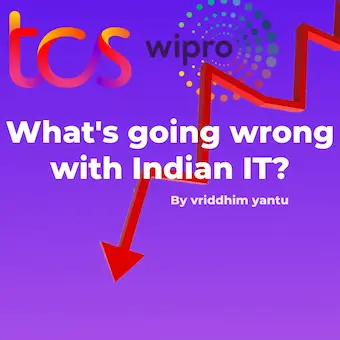What’s Going Wrong with Indian IT Companies in 2024?

For decades, India’s Information Technology (IT) sector has been hailed as the crown jewel of its economy — a sector that gave birth to globally recognized companies like Infosys, TCS, Wipro, and HCL Technologies. These companies powered the back offices of the world, created millions of high-paying jobs, and helped India establish its position on the global tech map.
But today, cracks are beginning to show. Growth is slowing, profit margins are shrinking, layoffs are rising, and investors are growing skeptical. The Indian IT sector, once synonymous with relentless growth and opportunity, now finds itself navigating turbulent waters.
Why Are Indian IT Companies Struggling?
The problems facing the industry today are multi-faceted. While some are short-term headwinds, others hint at a deeper structural shift that may force the industry to reinvent itself.
1. Global Demand Slowdown
A major chunk of Indian IT revenue comes from North America and Europe. But these regions are grappling with economic uncertainty, rising interest rates, and fears of a possible recession. As businesses cut down on discretionary spending, IT outsourcing budgets have also been slashed.
Many clients have delayed or canceled their digital transformation projects, leading to fewer large deal wins and thinning pipelines for major Indian firms.
2. Overdependence on Traditional Outsourcing
The traditional IT services model — where Indian companies provided back-end support, maintenance, and infrastructure services at lower costs — is now outdated. With the rise of automation, AI, and no-code tools, many of these services are being automated or handled in-house by global firms.
In short, the "low-cost labor" advantage that India once enjoyed is being eroded rapidly.
3. Talent Crunch and High Attrition
Despite layoffs and hiring freezes, Indian IT companies are still struggling with a talent mismatch. The demand is for cloud engineers, cybersecurity professionals, and AI experts — but the supply is short. Meanwhile, freshers and mid-level engineers trained in legacy systems are finding it difficult to adapt.
The industry also witnessed record-high attrition in the past two years, which has made workforce stability a major concern.
4. Margin Pressure from Rising Costs
During the COVID boom, companies increased salaries, handed out bonuses, and onboarded thousands of employees in anticipation of continued demand. But now, with revenue growth tapering off, these costs have become a burden.
Operational margins have declined for almost all major players, and managing profitability has become a key challenge.
5. Increasing Global Competition
Indian IT no longer dominates the outsourcing market like before. Global consulting firms like Accenture and Capgemini, as well as Eastern European and Southeast Asian tech hubs, are now giving Indian IT stiff competition — often offering better quality at comparable prices.
Moreover, the emergence of cloud-native startups and remote-first companies has added a new layer of global rivalry.
What’s Happening Inside These Companies?
Hiring Freezes and Layoffs
Top IT firms have drastically slowed down their hiring. Entry-level onboarding has been paused at companies like Infosys and Wipro. Many offer letters to freshers from 2022 and 2023 remain unfulfilled even today.
Layoffs have also quietly started across support functions, especially in HR, training, and middle management.
Shift Towards High-Margin, High-Skill Work
To counter low-margin business erosion, companies are pushing into cloud, cybersecurity, AI, and data analytics services. However, these segments require niche skills, strategic partnerships, and a global delivery mindset — something the legacy-heavy Indian firms are still building.
Workplace Transformation Post-COVID
The pandemic altered how work is done. Many employees are reluctant to return to full-time office setups. While some companies are pushing for hybrid models, others like TCS and Infosys are facing backlash from workers demanding flexibility.
Employee morale, team productivity, and organizational culture are all undergoing transformation — but not without friction.
Is It a Temporary Dip or a Permanent Shift?
That’s the million-dollar question. While some analysts believe the sector will bounce back once macroeconomic conditions stabilize, others argue that the Indian IT model needs a reinvention.
Companies can no longer rely solely on cost arbitrage or headcount-based billing. Instead, they must pivot to value-based pricing, invest in IP (Intellectual Property), build SaaS products, and enhance their consulting capabilities.
The transition won’t be easy, but it’s necessary for survival and future growth.
What Can Investors and Professionals Expect?
- Short-Term Pain: Flat revenues, squeezed margins, and cautious guidance from most IT companies are likely to continue for the next few quarters.
- Selective Hiring: Only high-skilled roles will be in demand. Campus hiring may remain muted for another year.
- Re-Rating of Valuations: Investors will now look at IT stocks more cautiously, focusing on profitability and future-readiness rather than past growth.
Conclusion
Indian IT companies are at a crossroads. The old playbook of headcount-led growth and offshore cost savings is slowly fading. What lies ahead is a more competitive, skill-driven, and innovation-led future.
Whether Indian IT can adapt to this new era will determine if it can retain its global leadership or be disrupted by newer, more agile players.
Only time — and transformation — will tell.